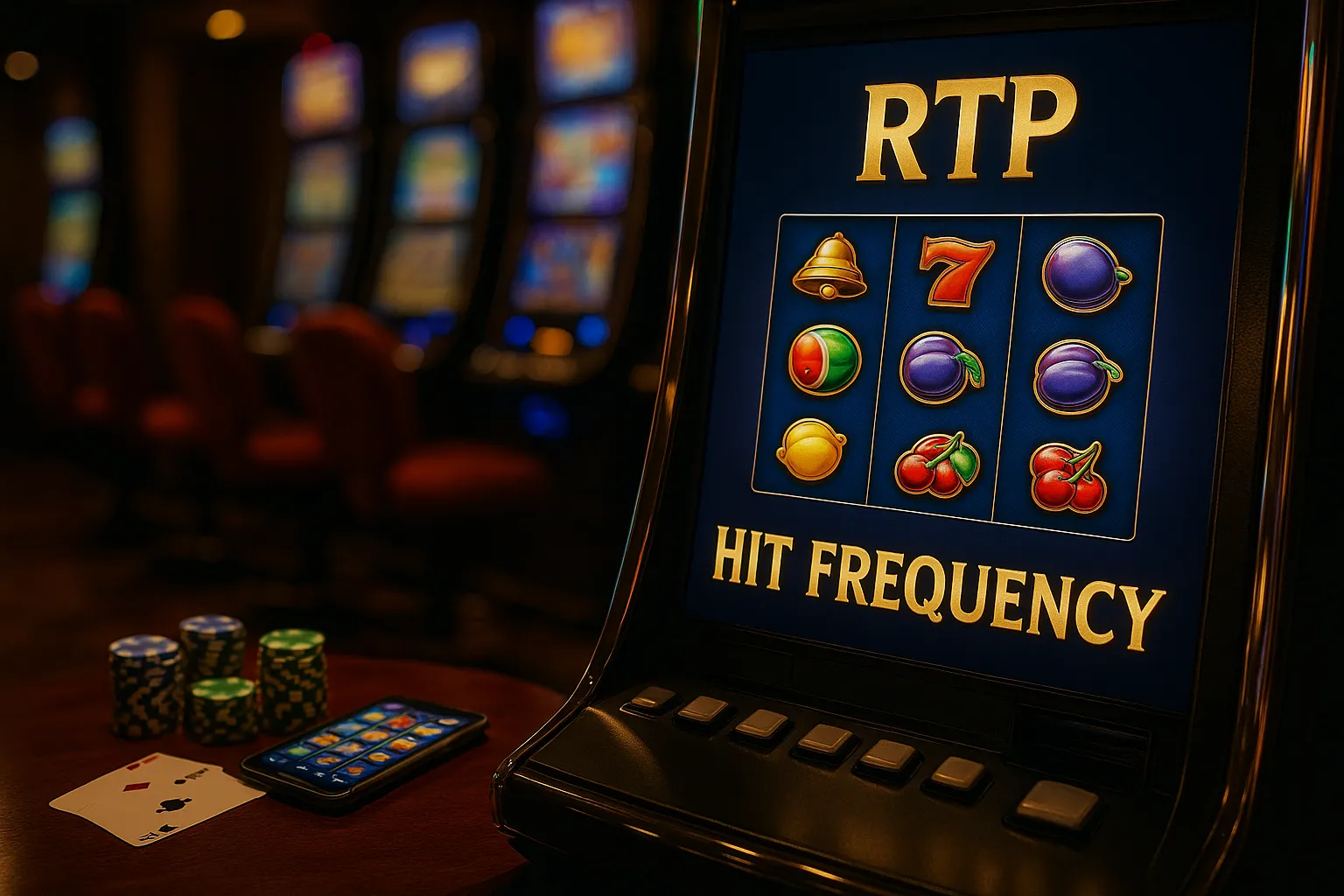If you’ve ever stared at a slot’s info panel wondering whether “96% RTP” means it will actually pay you back £96 from every £100, or puzzled over why a game with a 30% hit rate still rinsed your balance, you’re not alone. I’ve been logging sessions, comparing notes with other grinders, and learning the hard way that RTP and hit frequency measure completely different things. Understanding both—really understanding them—can save you money, frustration, and a lot of “this slot is rigged!” rants.
RTP in Plain English
Return to Player (RTP) is a long-term statistical average. If a slot advertises 96% RTP, it means that over millions of spins, the game is designed to give back £96 for every £100 wagered. It’s not a promise to you; it’s a promise about the game’s overall math. Think of RTP as the casino’s way of saying, “Here’s how sharp our edge is over the long run.” A 96% RTP slot effectively has a 4% house edge. Some games let operators choose from several RTP versions (e.g., 96%, 94%, 91%), so always check the version you’re actually playing—especially true on sites with flexible configurations.
RTP also doesn’t tell you how those returns are distributed. One game might pay you small drips constantly. Another hoards value then explodes during bonus rounds. Both can still average 96%, but your journey getting there feels wildly different.
Hit Frequency Feels Different Because It’s About “How Often,” Not “How Much”
Hit frequency (or hit rate) tells you how often a spin results in any win—could be a tiny 0.2x refund, could be a mega feature. A 30% hit rate means roughly three hits every ten spins. But those hits might be micro-wins that don’t even cover your stake. I’ve played “high hit rate” slots that felt generous but slowly bled me dry because most hits were token amounts. Conversely, low-hit-rate games can feel brutal until a chunky payout lands.
This is where player psychology kicks in. If you need constant reinforcement to stay calm—little wins to keep morale up—a high hit frequency slot may be kinder to your nerves. If you’re comfortable sitting through stretches of nothing in hopes of one big spike, a lower hit rate tied to higher-value features might suit you better. And when you hunt for uk betting sites fast withdrawal options outside the usual mainstream, remember to vet them like you would any wellness retreat—you wouldn’t blindly book a retreat without checking credibility, just like you wouldn’t skip reading terms on uk betting sites fast withdrawal. Fast cash-outs are great, but only if the platform is transparent about RTP versions and honest about game settings.
Volatility Bridges the Gap Between the Two Metrics
Volatility (sometimes shown as variance) describes how bumpy the ride is between deposits and withdrawals. High-volatility slots tend to have lower hit frequencies and rely on rare but significant payouts. Low-volatility games win more often but usually pay smaller amounts. RTP stays the same, but the emotional and financial path to that average shifts dramatically. When you see “high volatility + 96% RTP,” translate it as: “You’ll probably endure long losing stretches, but the math expects occasional big pots to even things out—eventually.”
Why Two 96% RTP Games Can Feel Like Night and Day
Imagine:
-
Game A: 96% RTP, 35% hit rate, low volatility. You see lots of 0.3x–1.5x wins, rare big bonuses.
-
Game B: 96% RTP, 18% hit rate, high volatility. Long droughts, but when it hits, it’s 100x+.
Both return 96% over time, but your mood—and bankroll—will ride very different curves.
RTP Isn’t Fixed in Your Session
The “RTP over millions of spins” caveat is crucial. In a 200-spin session, you could see 20%, 150%, or anything in between. That’s variance. Don’t chase losses because “the RTP owes me.” It doesn’t. Similarly, don’t believe a hot streak means you’ve “beaten” the RTP; it just means you hit a positive patch in a chaotic distribution.
Operator-Selectable RTP: The Sneaky Setting
Many modern slots allow casinos to choose a lower RTP variant to increase profit margins. A game famous for 96% RTP might quietly be running at 92% somewhere else. Reputable sites state the exact version in the info pane. Shadier ones bury it. If you care about maximising value, always peek at that paytable info screen.
Hit Frequency Can Lie by Omission
A 30% hit rate sounds friendly, but what counts as a “hit”? Sometimes a 0.10x return triggers animation and increases the counter. Technically a hit; practically a shrug. The metric doesn’t break down win sizes, only occurrences. So use hit frequency to gauge “pace,” not profit. The true heartbeat of a slot is how its paytable and features distribute prize sizes, not just how often anything lands.
Session Goals: Entertainment Time vs. Big-Game Hunting
When I want to stretch a small bankroll and just zone out, I pick higher hit-rate, lower volatility titles. My balance trickles but I get lots of “action.” When I’m in the mood to swing for the fences—with a budget I’m willing to torch—I go for high-volatility, lower hit-rate slots. The decision isn’t “which is better,” it’s “which suits today’s plan?”
Real Examples from My Spreadsheet Habit
I tracked a week on a low-volatility, 33% hit-rate game. Out of 1,000 spins, I logged 327 wins. Average win size? 0.68x stake. Net result: -7% bankroll. Boring? Sure. But it gave me 5+ hours of playtime. Another week I tested a 22% hit-rate beast with a huge bonus potential. Only 223 wins out of 1,000 spins, but one bonus alone paid 250x and put me +18% overall—even after lots of dead spins. Without that single hit, I’d have finished deep in the red. That’s volatility in action.
Emotional Bankroll Matters as Much as the Math
You can know every stat, but if a dry run tilts you into doubling stakes or chasing losses, the numbers won’t save you. High-volatility, low-hit-rate games demand emotional resilience. High-hit-rate, low-volatility games can lull you into overplaying because it “doesn’t feel bad” losing slowly. Know your triggers and set both money and time limits before you start.
Practical Ways to Use RTP and Hit Frequency Together
Start by asking: “What kind of session do I want?” Long and steady? Look for mid-to-high hit frequency with mid-to-low volatility. Thrill ride? Lower hit frequency, high volatility, and a bankroll you can afford to watch swing. Then check RTP to avoid games where the house has secretly beefed up its edge with a low-version setting.
The Hidden Role of Features
Many slots combine mechanics to blur hit rate and RTP perception. A cascade game might boost hit frequency with tiny chain wins, while an escalating multiplier makes the bonus round your real payday. Always read how features interplay. If a slot advertises “hit frequency 32%” but most wins are mini cascades paying peanuts, don’t be surprised when your balance slides. Conversely, a game with an “average” hit rate but sticky wilds or persistent multipliers might be quietly generous over fewer wins.
Fast Withdrawals and Real-World Considerations
All the theory in the world won’t help if you hit a nice payout and can’t get your money quickly. That’s why I vet cash-out terms as carefully as I study paytables. Fast withdrawals aren’t a luxury; they’re part of responsible play—cash out wins before temptation drags you back. On any platform you use, confirm processing times, fees, and caps. I’d rather play a 95.5% RTP slot on a site that pays instantly than a 96.5% slot where withdrawals drag for days and I’m tempted to redeposit.
Final Verdict: They Answer Different Questions
RTP answers “How much value does this game return over the very long run?” Hit frequency answers “How often will I feel like I’m winning something?” Neither guarantees profit; both shape your experience. Use them together, add a dash of volatility awareness, and—most importantly—tune them to your mood and bankroll goals. Slots should entertain, not stress you out. Pick the math profile that supports the fun you actually want.










